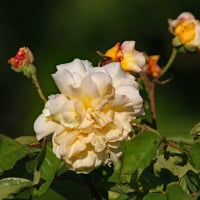This Forum will close on Wednesday 27 March, 2024. Please refer to the announcement on the Discussions page for further detail.
Comfrey fertilizer
 Collareddove
Posts: 173
Collareddove
Posts: 173
I have loads of comfrey in my garden - hidcote blue and hidcote pink, not the tall wild variety.. Are all parts of the plant (leaves, flowers, stems and roots) suitable for making fertilizer? How long should it keep it 'steeping'? Should I wait until it gives off that unmistakeable odour?
0
Posts
The old school way is to scrunch the comfrey foliage in a deep bucket and then cover with water and then a lid. Leave a couple of weeks to steep, stirring occasionally. Strain the resulting liquid into a container and dilute 1 x comfrey liquid to 10 x water and use as a liquid feed or a foliar spray.
A less smelly way is to find a deep container into which you can sit a less deep plant pot that will fit on the rim. Fill the plant pot with as much comfrey foliage as you can and then weight it down with a stone or brick. The juices will seep down into the container below and can then be diluted as above.
Whichever method you use the residue of squished or rotted comfrey leaves can go on the compost heap.
. We usually leave ours for one month to soak. We use a cheap black plastic dustbin to make ours. If you can keep it somewhere where it gets a few hours of direct sunlight each day, this will also help speed up decomposition.
You can use the mushed foliage after you have finished. It can be used as a mulch around plants (as can raw Comfrey leaves), and it acts as an accelerator on your compost heap.
We put our finished juice into a water butt, which makes it easy to access when we need it, but you need to stir the contents before use, as the gunk tends to collect at the bottom of the butt.
One word of warning if you are planning to bottle and store it, you need to open the lid quite often because if you forget, the pressure can build up and explode the bottle, hence why my shed still stinks of comfrey tea.
Comfrey roots go deep and pull up a wider range of minerals from the soil and are good for flower and fruit production hence their value as a fertiliser for roses and tomatoes and any other fruiting and flowering pant.
Seaweed is good for potatoes, sweetcorn, peppers, apples, strawberries as it contains a substance that helps the soil retain water.
Grass clippings are high in nitrogen and weeds in general can be composted or made into a tea that is high in nitrogen.
Horsetail (weed) can be used to make a good fungicide.
"Have nothing in your garden that you don't know to be useful, or believe to be beautiful."